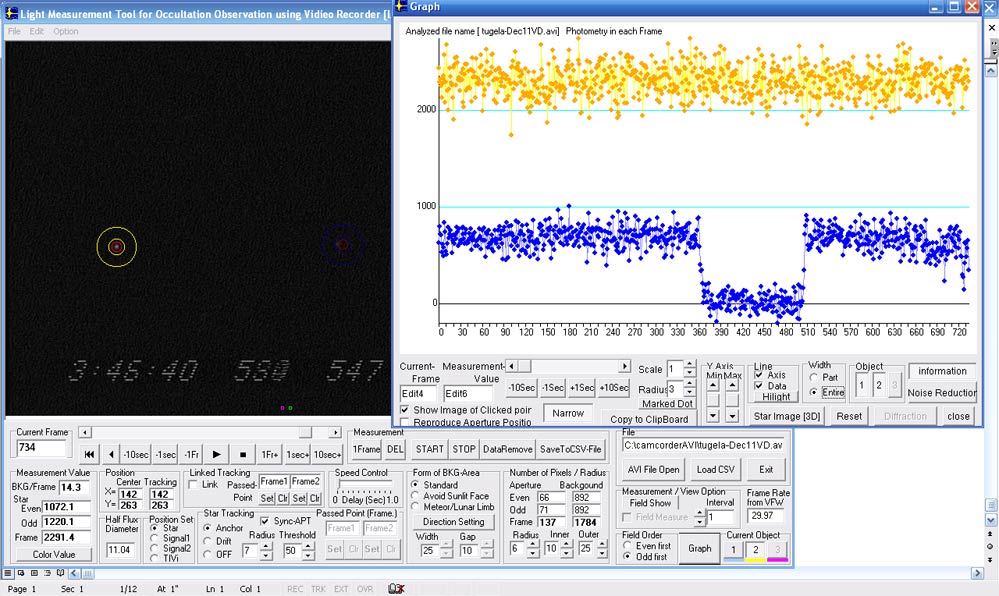

The occultation of a 10.3 star by the asteroid Tugela - A bright, relatively favorable asteroid event worth a try from Cabrillo Observatory. The rank was only 48, and the path was predicted to be a bit offshore and odds were low; I was at track +75.5km, but it was a bright star high in the sky, and a good excuse to get together my astrophotography posse who could be shooting cool galaxies and star formation regions with the 12" in the dome warm room while I got the occultation. Skies were clear and very cold, in the 30's before it got too dark, at the canyon location of the observatory. The predicted time at longitude=122 (Santa Cruz), was 3:45:49 UT Dec 21. I got the 10" Meade set up OK, got a start on calibration, when the scope suddenly went haywire and launched off on it's own agenda. I powered off, powered on and it seemed to have come to its senses... did a 2-star align and it seemed to be OK. Found the target easily, got it in the LCD of the camcorder and waited. The scope did drift off for some unknown reason while I wasn't looking, and I had to use the finderscope to get it back on, then watched like a hawk for the last 15 minutes to be sure it didn't wander off again. Flakey potentiometers, is the guess.
The predicted time came and went with no event and I sighed, took my eye off the LCD camcorder screen, but let it keep taping for a while and wondered when I should power off, deciding on 10 time the predicted 10-sec event length, or nearly 2 min after predicted time. Then I looked back and said... 'hey, where'd my star go?', and it came back. It looked like it was an occultation but I wasn't sure. I let it run another minute, then tried to replay. Turns out my remote batteries, sitting at 32F, gave up the ghost at this time, so I had to scramble and find more batteries rummaging around in the observatory. Then replayed and sure enough - I got the occultation! 40 seconds late! That's 4x the asteroid's expected diameter and more than I would have guessed from the 1-sig limits.
Had some trouble with my own instructions on using LiMovie to generate a .csv file. I couldn't get the software to track on the bright nearby guide star and synch with the target annulus. The target annulus using my original instructions (click 'link' and 'drift' for both stars) would wander off looking for the target when it disappeared while the other annulus stayed locked onto the guide star. I had success when I clicked 'anchor' and no linkage for both stars.
Here's the LiMovie output from analyzing the tape... the bright 8th magnitude guide star is shown in yellow, and the target V=10.3 (B-V=0.5) star in blue.

And here's the Occular 4.0 analysis. As always, click on the image to get a full resolution readable version...
|
The final report from Occular |
The IOTA Excel report is here.
We had five other observers for this. Derek Breit, at +95km, had a miss, as did Walt further north, and Karen Young at Wrightwood, and Greg Lyzenga, to the south of the path. Derald Nye in Tucson also had a miss, as did Looks like we had a north shift and a much bigger shift along the path itself, in the time direction. More misses from G. Thomas and D. Oesper. With my single track, we didn't get a solid diameter out of this one, unfortunately.
Also, I finally got around to measuring the FOV of the pc164cEX2 camera as shown on the ZR45mc LCD screen. 15' x 9.9'